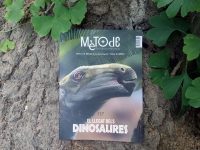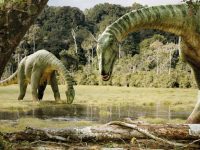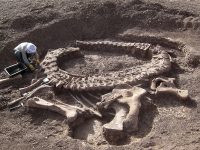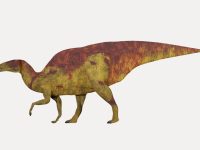What is the most giant sauropod from Argentina?
Diversity of large titanosaurs from Patagonia
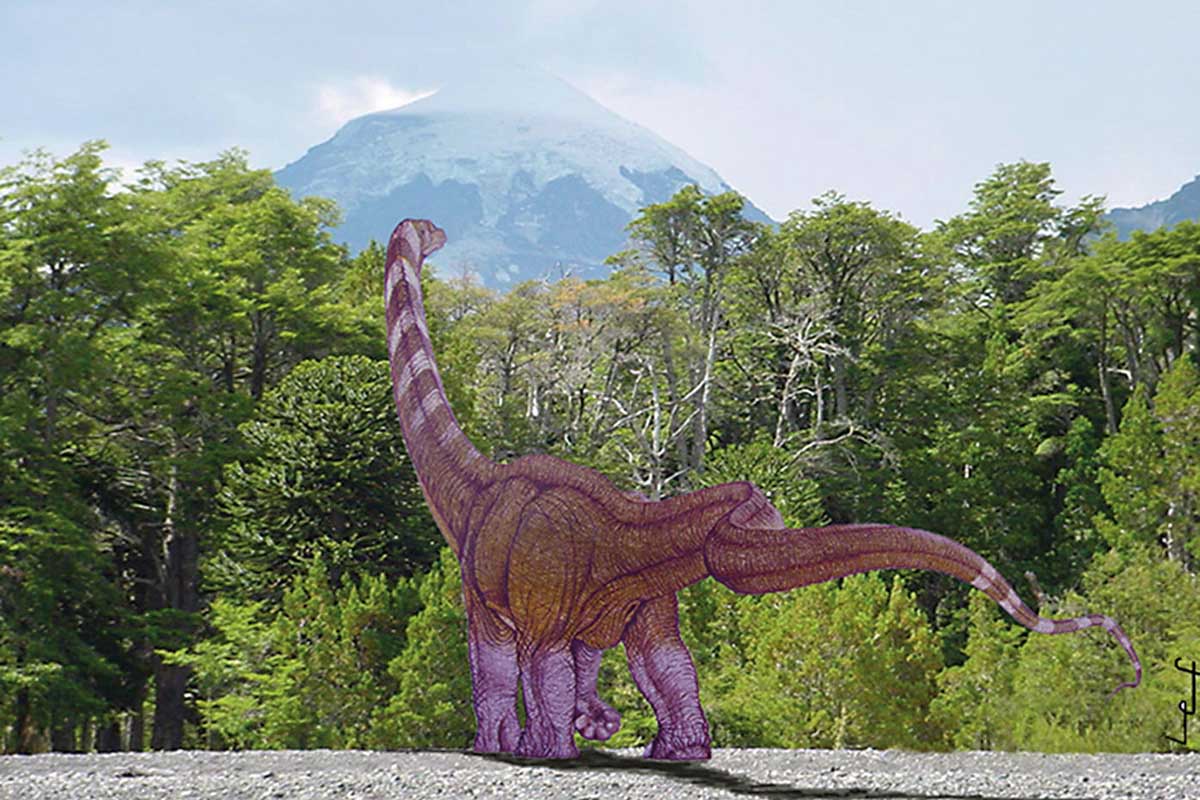
This work’s intent is to establish which was the most giant titanosaurid sauropod from Argentina. The evidence is scarce; however, we have tried to select the largest bones of the nine most giant titanosaurids. Argentinosaurus has been proposed as the largest titanosaurid, but recently a new king has been erected: the Patagotitan. In this review, we will see that there are some inconsistences and difficulties to define which is the largest. In other words, giant titanosaurids were a group of sauropods with a variable morphology and probably the overall shape was different. Among the largest titanosaurids, we have included Argyrosaurus superbus, Antarctosaurus giganteus, Argentinosaurus huinculensis, Puertasaurus reuili, Futalognkosaurus dukei, Traukutitan eocaudata, Dreadnoughtus schrani, Notocolossus gonzalezparejasi, and Patagotitan mayorum.
Keywords: sauropods, titanosaurids, Argentina, Cretaceous, Patagonia.
In the last 50 years, giant dinosaurs have been of great interest for both the science community and the media. The reason is clear: humans are fascinated with giant things or animals, which makes dinosaurs very important because they were the largest terrestrial animals that ever lived on Earth. Among them, sauropods were the kings. Giant sauropod fossils are widespread over the world but in the last 20 years, many of the largest ones come from Argentina and all of them belong to the Titanosauria clade. Titanosaurs were a group of derived Titanosauriform sauropodomorphs that lived during the Cretaceous, mainly from Aptian to Maastrichtian times (120 to 66 million years ago). Up to now more than 70 titanosaurian species have been recognized in South America and here we have selected nine of the most gargantuan.
Usually, the skeletons of large-bodied animals are (have always been) quite easily destroyed during the process of biostratinomy and diagenesis (exposure and burial). We know that the larger the dinosaur, the less evidence we tend to find, because predators find big dead animals easily and destroy most of the body. Therefore, most of the largest skeletons found are fragmentary; we usually preserve a few bones, and even fewer skull elements. When we try to estimate the body size for each taxon with certainty, there is not enough evidence; in other words, body size is merely tentative, because most of these taxa are represented only by partial fragmentary remains. Paul (2019) tried to measure the body mass using modeling and evidence from some bones such as dorsal vertebrae, humeri, and femora; in this paper, we use data from these bones to have an idea of body volumes. In this review, to select the biggest titanosaurid, we will choose, if available, those with femora longer than 180 cm.
Nevertheless, well-preserved giant animals are scarce, an exception being the nearly complete single specimen of Futalognkosaurus. All of the larger sauropods in South America come from Argentina; they are: (1) Argyrosaurus superbus, (2) Antarctosaurus giganteus, (3) Argentinosaurus huinculensis, (4) Puertasaurus reuili, (5) Futalognkosaurus dukei, (6) Traukutitan eocaudata, (7) Dreadnoughtus schrani, (8) Notocolossus gonzalezparejasi, and (9) Patagotitan mayorum.
What evidences is available from the most giant sauropods in Argentina?
Incredibly, when we think about giant sauropods, we talk about recent discoveries, mostly due to global media information. However, the oldest record of a giant sauropod in the world is Argyrosaurus superbus (Lydekker, 1893). It was discovered by Florentino Ameghino in 1888 and restudied by Mannion and Otero (2012). The holotype was found on the left bank of the Chico River, Chubut Province. Argyrosaurus is not the largest specimen today (Figure 1, Table 1), but it is big enough to be included in the list of giant titanosaurids, weighing around 25 tons, and having a 137-cm-long humerus and a 96.5-cm-long ulna (Table 10); the latter is larger than that of Futalognkosaurus dukei. Therefore, the femur was probably more than 180 cm long.
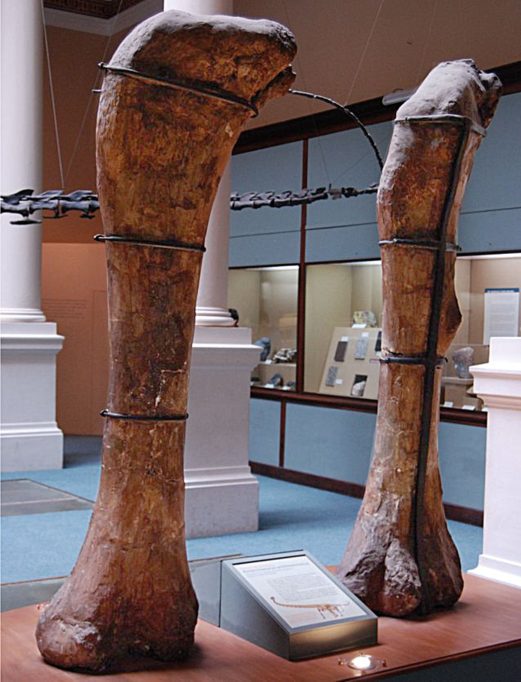
Figure 2. Holotype of Antarctosaurus giganteus in the La Plata Museum (Argentina). This species would have been one of the largest sauropods, with a body weight of about 69 tons. / Jorge Orlando Calvo
Beginning in the 20th century, Von Huene (1929) described the giant Antarctosaurus giganteus from Aguada del Caño, a municipality located 22 km west of Neuquén capital (Table 2), Neuquén Province. The materials are in poor shape, but the most impressive bones are the two femurs, one of them measuring 231 cm (Figure 2). The preserved pubis, lacking some of the proximal parts, is 145 cm wide (Table 10). With these dimensions, Antarctosaurus should be one of the largest sauropods, with a body weight of around 69 tons (Mazzeta et al., 2004).
In 1989 a paleontological team including Dr. Jose Bonaparte and Dr. Jorge Calvo of the National University of Comahue and Dr. Leonardo Salgado from the Cipolletti Museum excavated one of the largest titanosaurid sauropods (Figure 3) from the Huincul formation – probably, the most famous around the world, Argentinosaurus huinculensis (Bonaparte & Coria, 1993). It was discovered by a local farmer 5 km east of Plaza Huincul city, Neuquén Province (Table 3). The longest bone is the fibula (155 cm) described originally as a tibia. The widest neural arch on anterior dorsal vertebra is 126 cm wide (Figure 4). At the time the taxon was discovered, it was the largest dinosaur in the world and it was ruled as that for almost 20 years. The supposed weight is around 70 tons (according to Paul, 2019) or 73 tons (Mazzeta et al., 2004).
At the beginning of the 21st century, many other discoveries increased the number of giant titanosaurid sauropods. Puertasaurus reuili (Novas et al., 2005) is probably the largest titanosaurid, but the poor material collected impedes a comparison with Argentinosaurus huinculenis. The material recorded at Santa Cruz province includes just four vertebrae (Table 4). The anterior dorsal is the widest ever found, with 168 cm at the level of the transverse processes (Figure 5). The morphology is similar to that of Futalognkosaurus and Notocolossus. According to the big vertebrae size, it could probably reach almost 40 meters in length and 80 tons.
Two years later the finding of Futalognkosaurus dukei (Calvo et al., 2007) demonstrated that titanosaurids with large femora were not the longest nor the largest. The holotype was found at the north coast of Barreales lake, Neuquén province (Table 5). This taxon is up to now the most complete single specimen discovered of a giant sauropod (Figure 6). The longest bone is the femur (198 cm), but it also has very high anterior caudals (Table 10). The width of the posterior dorsals is 10 % shorter than that of Argentinosaurus. The most impressive bone is the sacrum, the largest preserved in the world, 255 cm wide (Figure 7; Table 10). The weight of Futalognkosaurus has been estimated in 29 tons (Paul, 2019).
Another fragmentary taxon is Traukutitan eocaudata (Juarez Valieri & Calvo, 2011) collected in 1990 by Dr. Calvo at Barreales lake, Neuquén province (Table 6). It was found 1000 meters away from the Futalognkosaurus site and on a different formation (Bajo de la Carpa Formation). The history shows how important knowledge of the completeness is when someone describes a fossil. The first description was made by Salgado and Calvo in 1993, but at that time the evidence did not allow experts to specify whether or not the material belonged to a new taxon. Some time later, the material was stored at the collection of the Museum of Geology and Paleontology of the National University of Comahue. Subsequent studies demonstrated that caudal vertebrae have primitive characters from the Titanosaurian group; therefore, a new redescription named it as Traukutitan eocaudata (Figure 8). The femur is the longest bone, with 197 cm (Table 10). Traukutitan resembles Futalognkosaurus, Mendozasaurus (González Riga, 2003), and Puertasaurus in the morphology of the base of the neural archs and the transverse processes on caudal vertebrae, suggesting that it represents a later Lognkosauria. The size and weight of Traukutitan might be around 30 meters and 30 tons, as that of Futalognkosaurus and Dreadnoughtus.
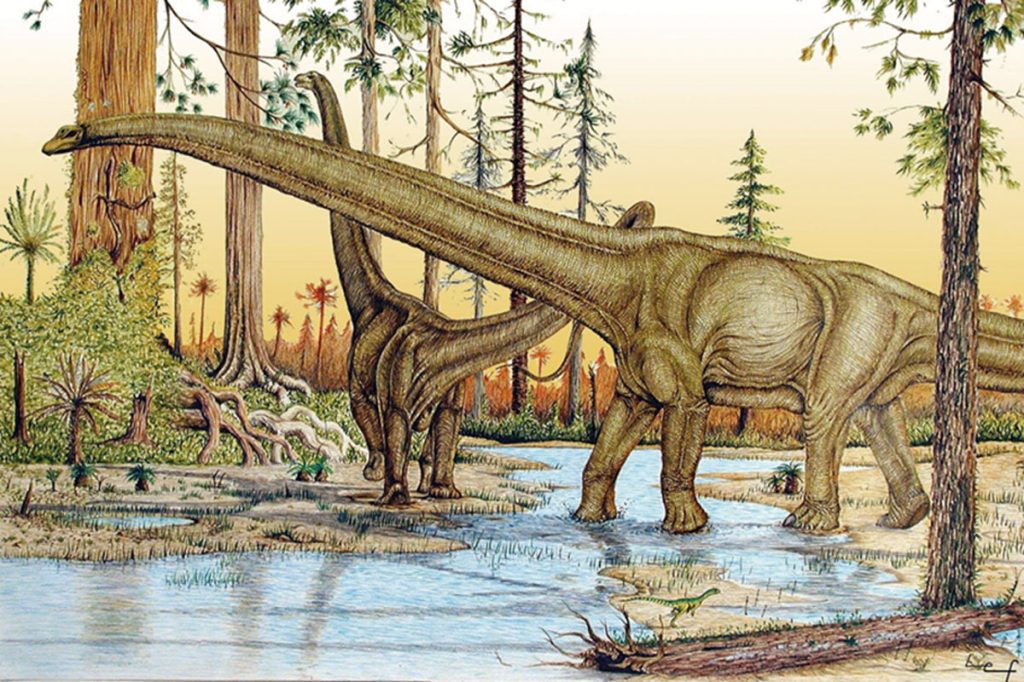
Figure 3. Representation of Argentinosaurus huinculensis. When the taxon was discovered in 1989, it was the world’s most gigantic dinosaur, and remained so for almost two decades. It was estimated to weigh more than seventy tons. / Courtesy of Lucas Fiorelli
Dreadnoughtus schrani (Lacovara et al., 2014) is one of the most complete giant titanosaurid skeletons: we have some cranial materials, vertebrae, and many pectoral girdle, forelimb, and hindlimb remains (Table 7). The materials come from Santa Cruz Province, south-western Patagonia, Argentina. At the time that Dreadnoughtus schrani was published, it became the most complete giant titanosaur preserved – approximately 45.3 % of the bones expected in a complete titanosaurian skeleton and (depending on how bones are counted) up to 70.4 % of the postcranial elements. However, as we saw before, the most complete specimen of a giant sauropod is Futalognkosaurus, with almost all the skeleton. We only lack skull materials, middle and posterior caudals, and some bones of the foot. Anyway, these two taxa are the most complete titanosaurids we can use to compare with other partial giant skeletons. With a 191-cm-long femur, Dreadnoughtus would be 26 meters long and weigh 31 tons (Paul, 2019).
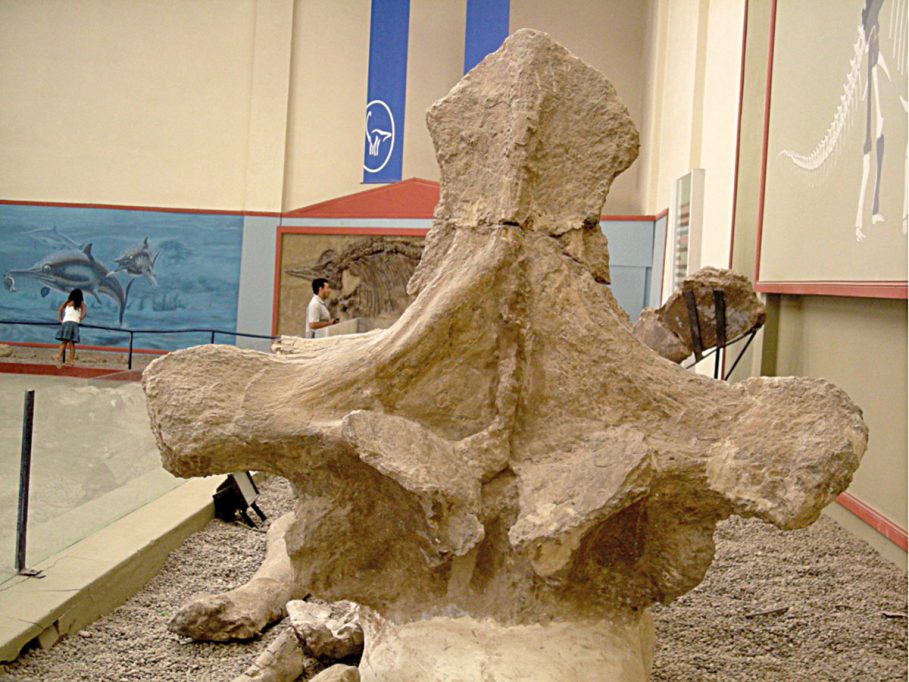
Figure 4. Holotype of the anterior dorsal of Argentinosaurus huinculensis. Its remains were discovered by a local farmer 5 km east of the town of Plaza Huincul, Neuquén Province, and excavated by Dr. José Bonaparte, Dr. Jorge Calvo, and Dr. Leonardo Salgado. / Jorge Orlando Calvo
Notocolossus gonzalezparejasi (González Riga et al., 2016) is the only record of a giant titanosaurid sauropod outside from Patagonia; it comes from southern Mendoza province. This taxon comes from the same geological Neuquén Group that Argentinosaurus, Antarctosaurus, Futalognkosaurus, and Traukutitan. The skeleton is based on two specimens whose anterior dorsal vertebrae would measure approximately 150 cm (Table 10) in maximum transverse dimension (i.e., the width across the diapophyses), only 18 cm less than in dorsal vertebra 2 of the gigantic Puertasaurus, and substantially greater than that of Argentinosaurus. This taxon is the most massive and has the longest titanosaur humerus yet recovered in the world, with 176 cm (Figure 9), 7 cm longer than that of the giant Egyptian titanosaur Paralititan. Using the length of the Notocolossus humerus, the probable length of the missing femur would be 216.6 cm; therefore, it might have weighed around 70 tons.
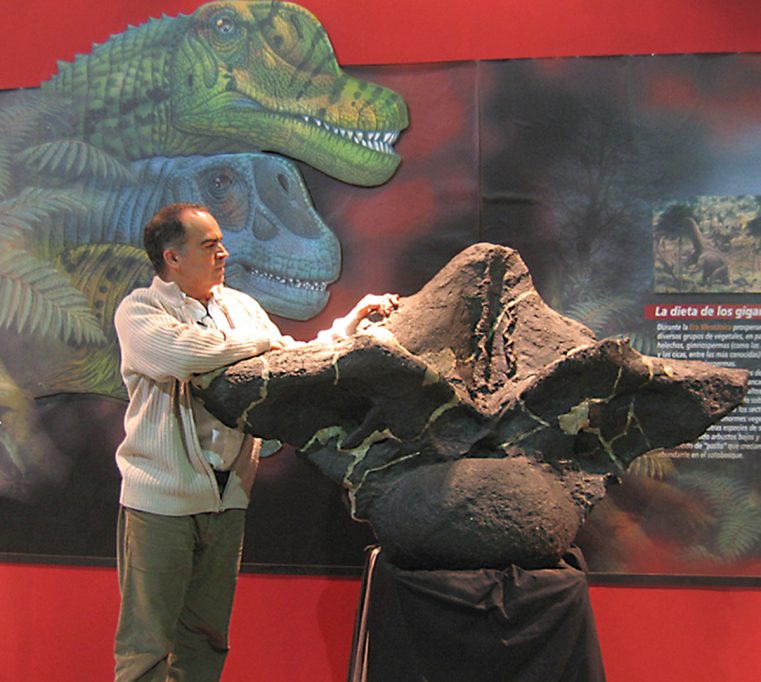
Figure 5. The anterior dorsal vertebra of Puertasaurus reuili (in the image, reconstruction of the holotype) is the largest ever found, at 168 cm wide. It probably belongs to the largest titanosaurid, but the scarce material collected prevents us from comparing it with other species, such as Argentinosaurus huinculenis. / Courtesy of doctor Fernando Novas
Very recently a new giant titanosaurid sauropod was discovered at Chubut province (Figure 10; Table 9), the Patagotitan mayorum (Carballido et al., 2017). The taxon is represented by at least six different specimens, but based on the taphonomical, histological, and ecological data available, they were interpreted as belonging to a monospecific sauropod assemblage (Carballido et al., 2017). The longest bone is the femur (238 cm), 7 cm larger than Antarctosaurus’, which is the main reason this taxon was supported as one of the largest sauropods in the world (Figure 11). Other big bones are the scapula (196.5 cm) and the ulna (105 cm) (Table 10). The rest of the materials are smaller with respect to other sauropods. The 152 cm pubis is the longest one preserved. Patagotitan includes many disarticulated bones from different specimens and sizes; therefore, the skeleton of an individual cannot be completed. Carballido et al. (2017) used the most complete giant skeletons – with pieces such as the precaudal of Futalognkosaurus and dorsals and caudals of Dreadnoughtus – to establish the position of each caudal vertebrae. The weight is around 52 tons (Paul, 2019).
An overview of giant bones
Some selected bones of giant titanosaurids have been measured to see differences in length or width (Table 10); here we will compare some of them.
Titanosaurid femora are the longest among dinosaurs. Up to now the longest preserved femur belongs to Patagotitan (238 cm) followed by Antarctosaurus (231 cm) (Table 10). Some pictures show a huge Argentinosaurus femur, but it does not come from the original excavation and it lacks both ends, so it is impossible to guess the real size and to which sauropod it belonged.
Titanosaurid humeri are smaller than femora; the longest humerus belonged to Notocolossus (176 cm), followed by Patagotitan (167.5 cm). Another giant titanosaurus from Africa was Paralititan (169 cm), but the largest is still that of Notocolossus.
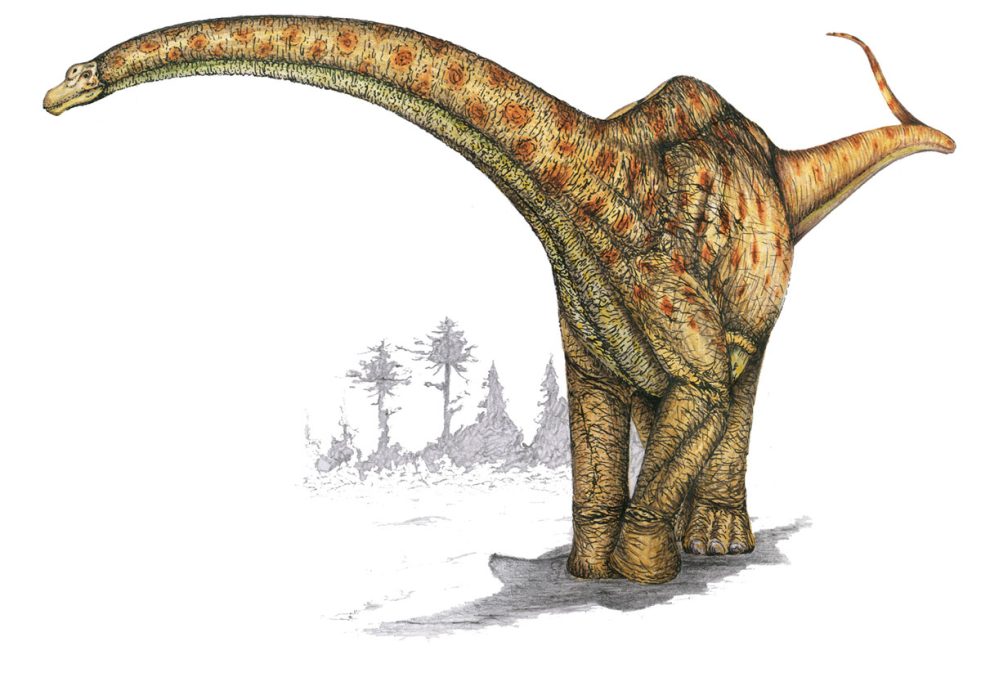
Figure 6. Representation of Futalognkosaurus dukei. The discovery of this species showed that titanosaurids with large femurs were neither the longest nor the largest. / Courtesy of Lucas Fiorelli
Titanosauria caudal vertebrae are the most common bones, preserved in many species; however, most of them are small; in the last 20 years, bigger caudals were found associated to articulated skeletons. Among the biggest caudals, we often use the most anterior ones because they are more accurate. The highest record is that of Futalognkosaurus (90 cm high) followed by Patagotitan (86.9 cm high).
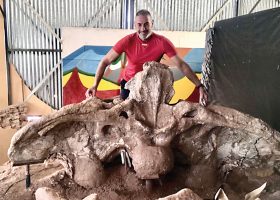
Figure 7. The author of the article, Jorge Orlando Calvo, next to the holotype of the sacrum of Futalognkosaurus dukei. This is the largest surviving sacrum in the world, 255 cm wide.
Dorsal vertebrae vary in size and morphology along the vertebral column, so the height or width depend of the position of each specific one. For many taxa, we do not have a complete sequence and therefore is complicated to compare with other species. Anyway, we usually try to differentiate anterior, middle, and posterior ones when comparing vertebrae. Argentinosaurus has an almost complete middle dorsal (the 4th?) whose neural arch is 126 cm wide at the level of the transverse process. In other taxa, the 2nd dorsal of Puertasaurus (168 cm) is wider than that of Argentinosaurus and followed by Notocolossus (150 cm). The rest of the taxa have shorter anterior dorsals (Table 10).
Giant pelvises are uncommon and the only one preserved is that of Futalognkosaurus (reaching 255 cm wide). This huge pelvis has the highest 1st caudal, 90 cm wide. It has been published that Patagotitan was one of the largest sauropods with 52 tons; however, if we establish the relationship based on pelvis evidence, that size seems to be quite far from reality. The Patagotitan caudal is a few cms smaller than that of Futalognkosaurus, even though the pubis of Patagotitan is 7 cm longer. It is possible that the sacra of both taxa would be similar. When we look at body weight relationships, it is difficult to accept that Patagotitan weighed 52 tons and Futalognkosaurus weighed 29 tons, as Paul (2019) indicated.
Dinosaur scapulae are very commonly found; however, few have been discovered from giant sauropods. The longest scapula is that of Patagotitan (196.5 cm) followed by Dreadnoughtus (174 cm) and Futalognkosaurus (170 cm). The scapula articulates with the humerus, and when establishing a humerus/scapula relationship, the result is 91 % for Futalognkosaurus and Dreadnoughtus, but only 85 % for Patagotitan. Probably, the Patagotitan scapula is not associated to the humerus, or the scapular blade is smaller in this taxon.
What is the largest titanosaurid sauropod?
When we talk about the largest sauropods, we can be confused about whether we are talking about total length, height, or even body mass. Generally, paleontologists use body mass because it is related to most biological processes; again, there is no complete skeleton record of all the specimens, so many of the interpolated data could be wrong. Therefore, if we try to infer body size, we usually use appendicular bones because they appear to be intimately related to these animals’ acquisition of a large body size. Some characters of limb bones appear to be directly related to their massive weight increase; these include columnar graviportal limb posture, increased femoral midshaft eccentricity, increased limb bone robusticity, and shortened distal limb segments. However, other bones such as pelvises or caudal and dorsal vertebrae have been used to compare sauropod sizes. Most of the body size estimations obtained for sauropods use femora and humeri (Carrano, 2006).
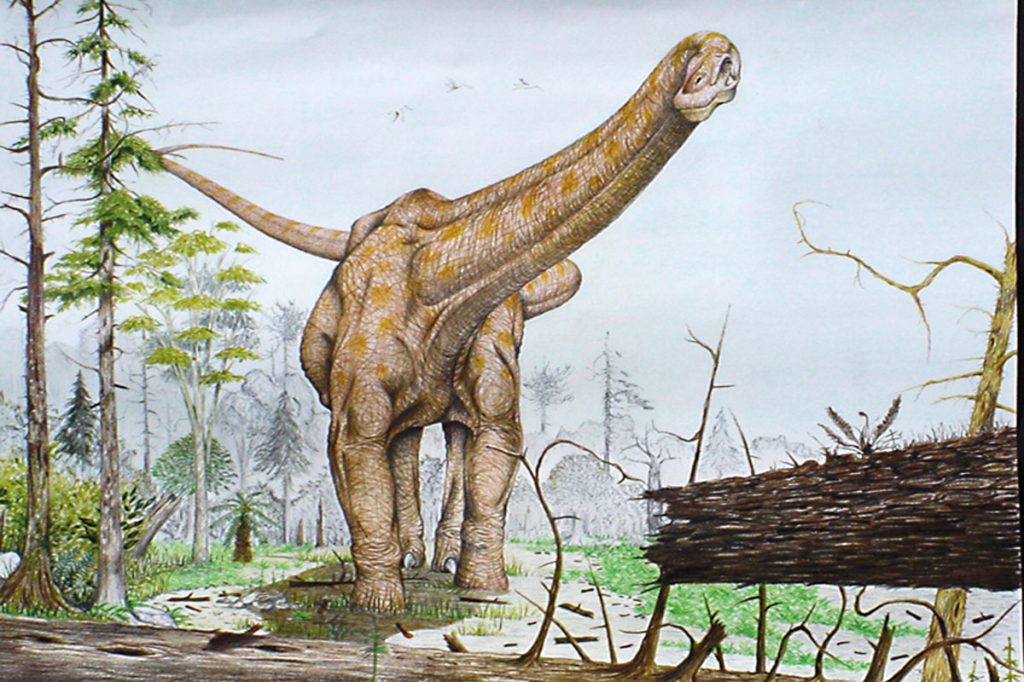
Figure 8. Representation of Traukutitan eocaudata. The size and weight of this dinosaur could be close to 30 metres and 30 tons, similar to Futalognkosaurus and Dreadnoughtus. / Courtesy of Lucas Fiorelli
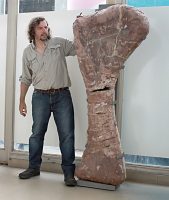
Figure 9. Holotype of the humerus of Notocolossus gonzalezparejasi. This is the longest titanosaur humerus in the world to date, at 176 cm / Courtesy of Bernardo González Riga
Establishing which is the largest titanosaurid from Argentina is quite difficult because only three taxa have relatively complete skeletons, and the rest are represented by isolated bones. The best-preserved skeletons we have belong to Patagotitan, Dreadnoughtus, and Futalognkosaurus. Many attempts have been made to establish which is the largest titanosaurid, but there are still some doubts regarding the results. For instance, both Dreadnoughtus and Futalognkosaurus have similar size, 26 meters long, and a weight of approximately 30 tons, but Patagotitan weighed 52 tons (Paul, 2019). That means that Patagotitan would be 80 % heavier than the other two; however, when we review the size of different bones, we do not see such difference. The largest bone differences of Futalognkosaurus and Dreadnoughtus with respect to Patagotitan are: humerus, 7 cm (5 %); femur, 40 cm (21 %); pubis, 15 cm (11 %); anterior dorsal vertebra, 26 cm (23 %); first caudal, -3 cm; ulna, 4 cm (4 %); scapula, 22 cm (13 %). Therefore, the estimated weight of Patagotitan seems too heavy if we compare the bones, so it probably should be smaller in size or weight; probably, it may be 25 % larger and weigh around 40 tons.
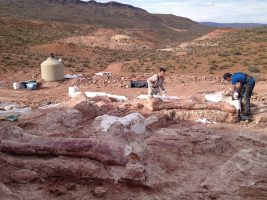
Figure 10. Excavation of Patagotitan mayorum showing the large bones found. / Courtesy of Pablo Puerta
Now, if we consider the rest of the largest incomplete titanosaurs, such as Argentinosaurus, Notocolossus, Puertasaurus, Traukutitan, and Antarctosaurus, few bones are comparable among them. As we see in Table 10, the longest femur belonged to Patagotitan, followed closely by Antarctosaurus. The largest humerus belonged to Notocolossus, followed by Patagotitan and, closely, by Dreadnoughtus and Futalognkosaurus. The question is why Argentinosaurus is placed as the largest titanosaurid, with 70 tons. We only have a few bones, with no humerus nor femur. When we study anterior dorsals in the different taxa of giant Titanosauria, we can see that there are two morphologies. Some have higher and wider distal neural spines, like Argentinosaurus and Patagotitan, while others have short and triangular neural spines, like Puertasaurus, Dreadnoughtus, Futalognkosaurus, and Notocolossus. This means that there are different body morphologies among titanosaurid sauropods, which could be associated to the disparity of bone dimensions.
According to the femur or humerus length alone, we could make a mistake by saying that the longer the humerus or the longer the femur, the largest the sauropod would be. For instance, the Notocolossus humerus (176 cm), together with the stylopodial proportions of more completely preserved titanosaurs, indicates the length of the missing femur at 216.6 cm (González Riga et al., 2016); but if we look at the robustness of Patagotitan, it is similar to Notocolossus (sensu Carballido et al., 2017) with a humerus/femur ratio of 0.7. Notocolossus might have had a 251-cm-long femur, which would represent the longest femur and, probably, the largest sauropod.
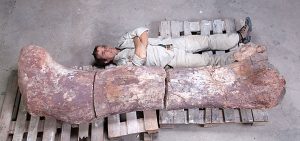
Figure 11. Femur from the holotype of Patagotitan mayorum. This bone is 238 cm long, the longest femur preserved to date. / Courtesy of J. Farfaglia
As we stated before, humerus and/or femur length might indicate a wrong size and weight estimate for a sauropod. On the other hand, vertebrae, scapulae, and pelvic bones are comparable in some titanosaurid candidates to the greatest titanosaurid sauropod. In sum, according to the size of the available bones and interpolating data with those of the most complete skeletons, the largest known Titanosauria should be Notocolossus or Puertasaurus, although further work – including the discovery of new fossils and a definitive method of size estimation – will be necessary to reach a consensus in the scientific community.
References
Bonaparte, J. F., & Coria, R. A. (1993). Un nuevo y gigantesco saurópodo titanosaurio de la Formación Río Limay (Albiano-Cenomaniano) de la Provincia del Neuquén, Argentina. Ameghiniana, 30(3), 271–282. https://www.ameghiniana.org.ar/index.php/ameghiniana/article/view/2163
Calvo, J. O., Porfiri, J. D., González-Riga, B. J., & Kellner, A. W. A. (2007). A new Cretaceous terrestrial ecosystem from Gondwana with the description of a new sauropod dinosaur. Anais da Academia Brasileira de Ciencias, 79, 529–541. https://doi.org/10.1590/s0001-37652007000300013
Carballido, J. L., Pol, D., Otero, A., Cerda, I. A., Salgado, L., Garrido, A., Ramezani, J., Cuneo, N. R., & Krause, J. M. (2017). A new giant titanosaur sheds light on body mass evolution among sauropod dinosaurs. Proceedings of the Royal Society B, 284, 20171219. https://doi.org/10.1098/rspb.2017.1219
Carrano, M. T. (2006). Body-size evolution in the Dinosauria. In M. T. Carrano, R. W. Blob, T. J. Gaudin, & J. R. Wible (Eds.), Amniote paleobiology: Perspectives on the evolution of mammals, birds, and reptiles (p. 225–268). University of Chicago Press.
González Riga, B. J. (2003). A new titanosaur (Dinosauria, Sauropoda) from the Upper Cretaceous of Mendoza province, Argentina. Ameghiniana, 40, 155–172. https://www.ameghiniana.org.ar/index.php/ameghiniana/article/view/951
González Riga, B. J., Lamanna, M. C., Ortiz David, L. D., Calvo, J. O., & Coria, J. P. (2016). A gigantic new dinosaur from Argentina and the evolution of the sauropod hind foot. Scientific Reports, 6, 19165. https://doi.org/10.1038/srep19165
Juárez Valieri, R. D., & Calvo, J. O. (2011). Revision of MUCPv 204, a Senonian Basal Titanosaur from Northern Patagonia. In J. O. Calvo, J. D. Porfiri, B. J. González-Riga, & D. Dos Santos (Eds.), Paleontología y dinosaurios desde América Latina (p. 143–152). EDIUNC.
Lacovara, K. J., Lamanna, M. C., Ibiricu, L. M., Poole, J. C., Schroeter, E. R., Ullmann, V., Voegle, K. K., Boles, Z. M., Carter, A. M., Fowler, E. K., Egerton, V. M., Moyer, A. E., Coughenour, C. L., Schein, J. P., Harris, J. D., Martínez, R. D., & Novas, F. E. (2014). A gigantic, exceptionally complete titanosaurian sauropod dinosaur from southern Patagonia, Argentina. Scientific Reports, 4, 6196. https://doi.org/10.1038/srep06196
Lydekker, R. (1893). Contributions to the study of the fossil vertebrates of Argentina. Taller de Publicaciones del Museo/La Plata.
Mannion, P. D., & Otero, A. G. (2012). A reappraisal of the Late Cretaceous Argentinean sauropod dinosaur Argyrosaurus superbus, with a description of a new titanosaur genus. Journal of Vertebrate Paleontology, 32(3), 614–638. https://doi.org/10.1080/02724634.2012.660898
Mazzetta, G. V., Christiansen, P., & Fariña, R. A. (2004). Giants and bizarres: Body size of some Southern South American cretaceous dinosaurs. Historical Biology, 16(2–4), 71–83. https://doi.org/10.1080/08912960410001715132
Novas, F. E., Salgado, L., Calvo, J., & Agnolin, F. L. (2005). Giant titanosaur (Dinosauria, Sauropoda) from the Late Cretaceous of Patagonia. Revista del Museo Argentino de Ciencias Naturales, 7, 31–36. https://doi.org/10.22179/revmacn.7.340
Paul, G. S. (2019). Determining the largest known land animal: A critical comparison of differing methods for restoring the volume and mass of extinct animals. Annals of Carnegie Museum, 85(4), 335. https://doi.org/10.2992/007.085.0403
Salgado, L., & Calvo, J. O. (1993). Report of a sauropod with amphiplatyan mid-caudal vertebrae from the late Cretaceous of Neuquén province (Argentina). Ameghiniana, 30, 215–218. https://www.ameghiniana.org.ar/index.php/ameghiniana/article/view/2155
Von Huene, F. R. F. (1929). Los saurisquios y ornitisquios del Cretáceo argentino. Universidad Nacional de La Plata.


